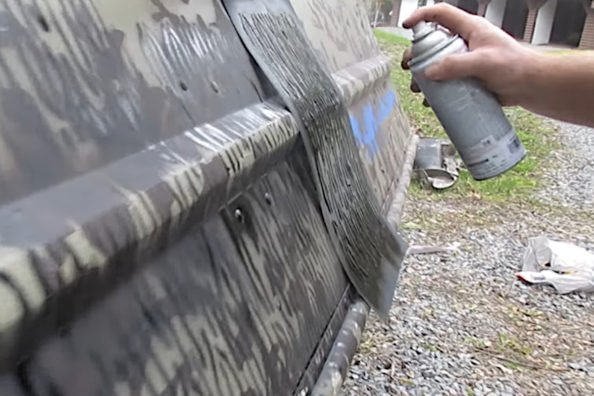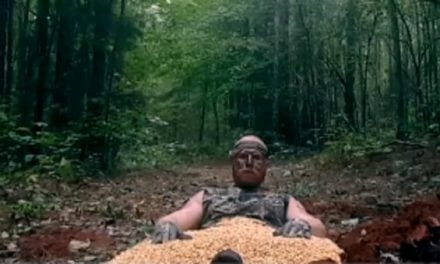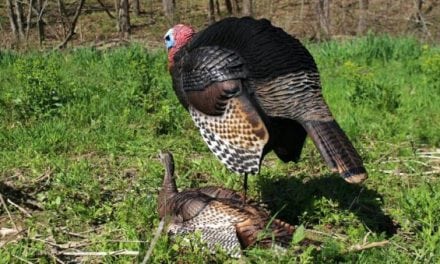
Here are some cheap ways to improve your waterfowl camo this season.
Having a good camo pattern is essential for almost any type of hunting whether you’re after big game, turkeys or in the case of this article, waterfowl. We won’t be talking hunting clothing like bibs, hoodies or parkas today. Instead we’ll talk about DIY camouflage patterns for your duck blind, boat or hunting gear.
You don’t have to spend a lot of money applying camo to these items. In some cases, it will cost you next to nothing except a little bit of your time. That means more money to spend on hunting clothes, decoys, waders, a new hunting jacket or hunting pants, or other gear. Some of these tactics can also be applied to whitetail deer hunting or even turkey hunting blinds this season.
Taking the time to apply this type of waterfowl camo now will mean more birds in the boat for any waterfowl hunter this season.
DIY Grass Mats
This is a bit of a time-consuming project. Sure, you could save some money by buying some Mossy Oak Shadow Grass gear and cover your stuff with the pattern, but nothing really beats an old school, natural gear approach. After all, what better way to break up your outline than by using something that will seamlessly blend into any wetland area?
There are few different ways of going about making one of these. One of the most popular is to weave canary grass, reeds, cattails or other natural materials on a DIY loom. The process creates mats about four to five feet high that are highly versatile. You can lay under them in a field or hang them off your duck boat.
This is a good project to take on with children. They can learn some craft skills while helping make something practical to use while hunting ducks later. You can instill a whole “hard work” pays off lesson from creating their own camo waterfowl pattern.
You could also invite your waterfowler buddies over on a Saturday afternoon before the season to knock out enough mats to last a year’s worth of hunting. Either way, you can’t go wrong with a material already in nature to fool those crafty ducks!
Another method to try is using commercially made materials like burlap or camo canvas. You know, the stuff they sell at just about every Walmart in the sporting goods section this time of year. If you want to save even more money, you can pick this stuff up dirt cheap at the end of the season once the clearance sales begin. Set it aside until the season and you can then cut up some of it into shredded strips like in the video above.
The guy in the video above attaches the shredded pieces of burlap to another piece of burlap with elastic bands and zip ties. He adds a little color to the mat with some camo spray paint. The result is a re-usable camo waterfowl hunting mat that if properly cared for, should last more than a few seasons.
Still a third option is a combination of these two techniques. You get the best of both worlds, the natural lines of the foliage combined with the staying power of the canvas/burlap material as the backdrop.
Pretty cool, huh? Just replace the natural parts each season. Set up, throw out your decoys and get to hunting!
Camo Duct Tape and gun wraps
Some people are worried about wrapping their guns themselves in camo. Will it ruin my barrel? This video addresses that issue.
It’s not just for your gun, too. For small pieces of waterfowling gear like hunting stools, support structures for your blind and gear boxes, this is as simple as it gets. Camo duct tape is relatively inexpensive. Again, check the big box stores at the end of hunting season. This stuff is almost always on sale and it sticks very well.
They also come in all the most popular commercially-made camo patterns like Mossy Oak Bottomland, Realtree Max and more.
We can’t say we recommend the route, especially for a new Benelli or Remington, if you’re extremely concerned about your barrel’s well-being.
But if you have an older shotgun laying around that you don’t use much anymore, it is something you could try. Just make sure you’re ok with potentially hurting the resale value of the gun!
If you are wanting to go this route for camouflaging a gun, we highly recommend going with a specialty-made camo gun wrap instead. These wraps are usually made to be easily removable later and won’t mar the finish of your firearm. They’re also a much cheaper option than buying a pre-camouflaged shotgun.
Camo spray paint
Camo spray paint is cheap and can be used in a variety of different camouflaging purposes for duck hunting. Whether you are looking to paint a gun or a whole boat, it’s relatively easy to do, although we recommend not rushing through the process, especially if you’re painting a shotgun!
First off, carefully mask off the areas that you don’t want to get painted and then start with a lighter base coat. Whenever painting any kind of pattern with spray paint, you want to start light and work your way darker. It won’t look right if you start the other way around. Trust me, I know from experience!
In the video above, this guy uses rubber bands around the length of the shotgun in order to get a grass or reed-like pattern. It doesn’t get much simpler than that. The end result is something that looks similar to Mossy Oak Shadow Grass Blades or Realtree Max-5, but without the huge price tag.
But you can also get a bit more elaborate. If you’re feeling creative, try making your own stencils using cardboard or construction paper.
Remember to think about negative space when you’re making stencils like this. The light colors are what will make the pattern blend in, or not.
Think about the area you’ll be hunting. Take photos for reference if you need help getting it right.
Another option is to use natural grasses and reeds as a stencil. I’ve done this in the past and it works very well for creating a realistic camo pattern. I imagine it’s how big names like Mossy Oak and Realtree got started.
One thing to remember when using any sort of stencil or natural material to help shape your spray paint is to keep the stencil or material as flat as possible. Otherwise you’ll have paint seeping under the edges and ruining the effectiveness of the pattern.
Another method to try is the sponge camo technique. It’s simple, requires less precision than stencils and makes a great-looking pattern.
Whatever method you choose, be sure to practice on a piece of scrap material BEFORE you start painting. Once you know what you want to do, you can do it in one pass without having to cake on the paint to fix your mistakes.
Products featured on Wide Open Spaces are independently selected by our editors. However, when you buy something through our links, we may earn a commission.
For more outdoor content from Travis Smola, be sure to follow him on Twitter and check out his Geocaching and Outdoors with Travis YouTube channels.
NEXT: ARE YOU READY FOR THE EARLY TEAL SEASONS?
The post 3 Totally Natural, DIY, or Cheap Ways to Have Great Camo for Waterfowl appeared first on Wide Open Spaces.
















